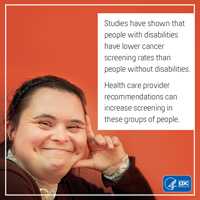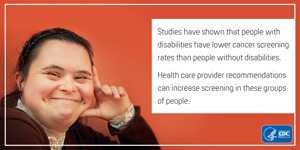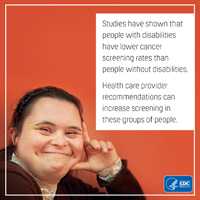Cancer Screening Prevalence Among Adults with Disabilities
People with disabilities are less likely than people without disabilities to receive recommended cancer screening tests.
In 2013, about one in five adults in the United States had a disability. People with disabilities often have trouble getting health care for many reasons, including not being able to schedule an appointment and not having transportation to the clinic. As a result, people with disabilities typically have lower cancer screening rates than people without disabilities, making it more likely that their cancer will be found later, when it is harder to treat.
This study looked at how many people with and without disabilities received recommended breast, cervical, and colorectal cancer screening tests in 2013, by type of disability. Overall, 17% of adults between ages 21 and 75 years were identified as having at least one of four disability types: hearing, vision, cognitive (a person’s ability to concentrate or make decisions), and mobility (difficulty walking).
Key Findings
Use of Cancer Screening Tests
Reported Pap test use for cervical cancer screening among women between ages 21 and 65 years with disabilities ranged from 66% to 80%, compared with women without disabilities (81%).
- Any disability: 72%.
- Hearing disability: 73%.
- Vision disability: 77%.
- Cognitive disability: 80%.
- Mobility disability: 66%.
- No disability: 81%.
Prevalence of having a mammogram for breast cancer screening among women between ages 50 and 74 years with disabilities also was lower (61% to 68%) compared with women without disabilities (73%).
- Any disability: 67%.
- Hearing disability: 67%.
- Vision disability: 64%.
- Cognitive disability: 61%.
- Mobility disability: 68%.
- No disability: 73%.
Screening for colorectal cancer was 57% among adults between ages 50 and 75 years without disabilities, and ranged from 49% to 65% among those with disabilities.
- Any disability: 62%.
- Hearing disability: 65%.
- Vision disability: 49%.
- Cognitive disability: 56%.
- Mobility disability: 63%.
- No disability: 57%.
Screening Recommendations
Women whose doctor recommended a Pap test or a mammogram were more likely to get the test, whether or not they had a disability. But women with a disability were still less likely to get tested than women without a disability.
Barriers to Screening
The most common reasons people gave for not getting screened were—
- Difficulty getting an appointment (9% of people with a disability and 5% of people without a disability).
- Wait time at the clinic is too long (7% of people with a disability and 3% of people without a disability).
- No transportation to the clinic (7% of people with a disability and 1% of people without a disability).
Citation
Steele CB, Townsend JS, Courtney-Long EA, Young, M. Cancer screening prevalence among adults with disabilities, United States, 2013. Preventing Chronic Disease 2017;14:160312.
Shareable Graphics
You can copy and paste the code to embed these shareable graphics in your Web site, social network profile, or blog.
- Page last reviewed: January 24, 2017
- Page last updated: January 31, 2017
- Content source:
- Maintained By:


 ShareCompartir
ShareCompartir


